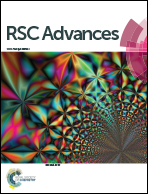QM/MM calculations and MD simulations of acetolactate decarboxylase to reveal substrate R/S-acetolactate binding mode and stereoselective catalytic mechansim†
Abstract
Acetolactate decarboxylase [EC 4.1.1.5] (ALDC) catalyzes both decarboxylation/protonation of the natural substrate and the rearrangement of the non-natural substrate, which is an interesting phenomenon in biological systems. It is a metalloenzyme that converts natural substrate (S)-acetolactate to (R)-acetoin by decarboxylation and subsequent protonation. For the enantiomer (R)-acetolactate, ALDC does not directly initiate decarboxylation to make (R)-acetoin; it has to carry out a previous rearrangement reaction to produce (S)-acetolactate. Formerly, due to the lack of detailed information on the enzyme structure, we could not predict what are the binding modes of the two enantiomers and how amino acids and zinc ion affect the rearrangement and decarboxylation. The recent crystal structures of the ALDC, developed computer technology and quantum mechanics help us to speculate the reaction mechanism. In this study, a hybrid quantum mechanical/molecular mechanical (QM/MM) method at the ONIOM level was used to elicit the details of the catalytic mechanism and energy profiles along the reaction at the atomic level. In the rearrangement process, the hydrogen bond between Glu253 and carboxyl of (R)-acetolactate is crucial when the carboxyl rearranges to adjacent carbonyl carbon to form (S)-acetolactate. In the decarboxylation process, ALDC catalyzes (S)-acetolactate by a two-step reaction. The first step is the carboxyl departure with the formation of an enediol intermediate and carbon dioxide. The next step is the protonation reaction on the face opposite to the enediol intermediate. The calculations show that the water-assisted protonation reaction is more favorable than that without water. Moreover, the protonation reaction is the rate-limiting step of the decarboxylation process. This study may help us to understand ALDC catalyzing R/S-acetolactate and similar stereoselective catalytic mechanism in biological systems.


 Please wait while we load your content...
Please wait while we load your content...